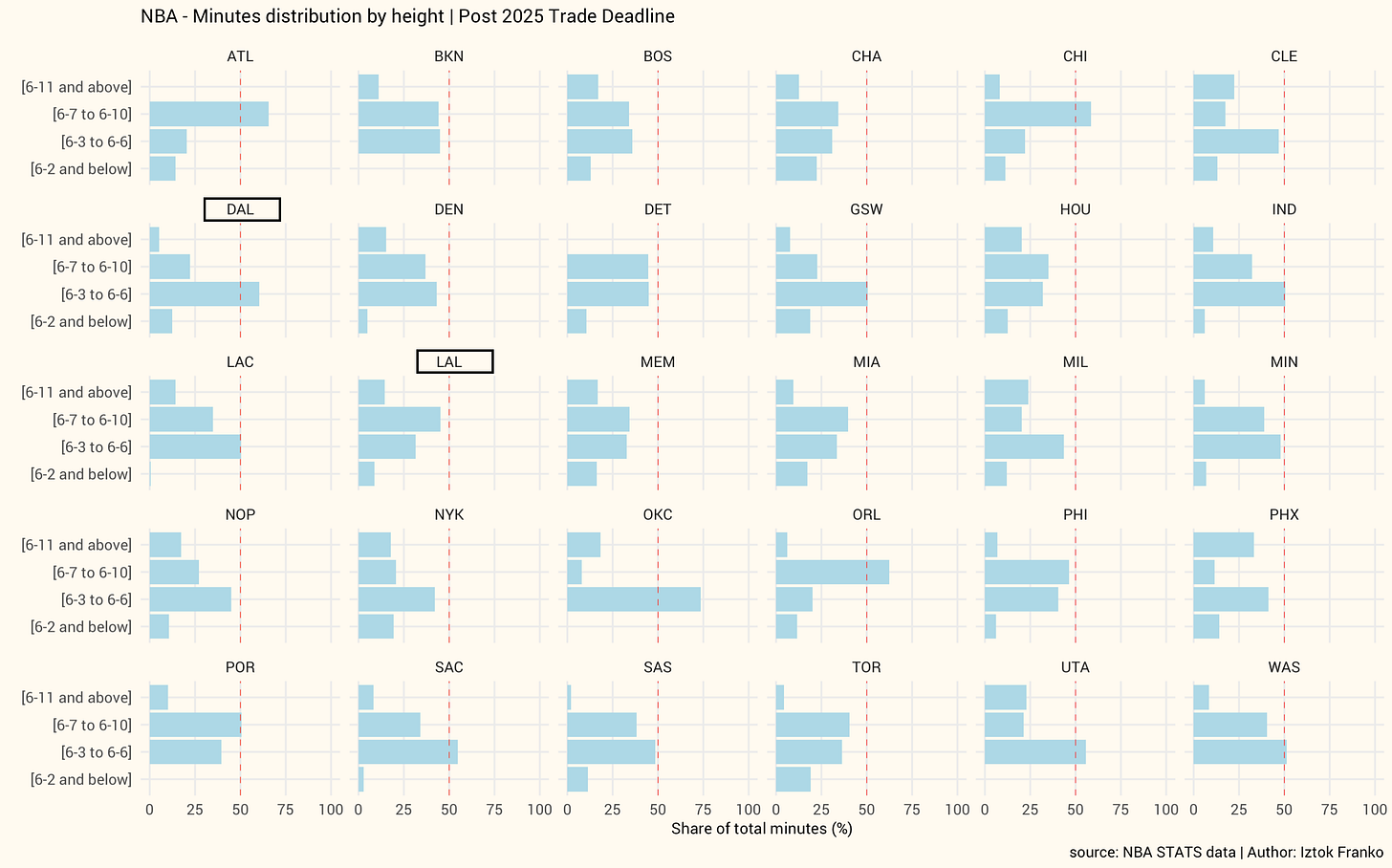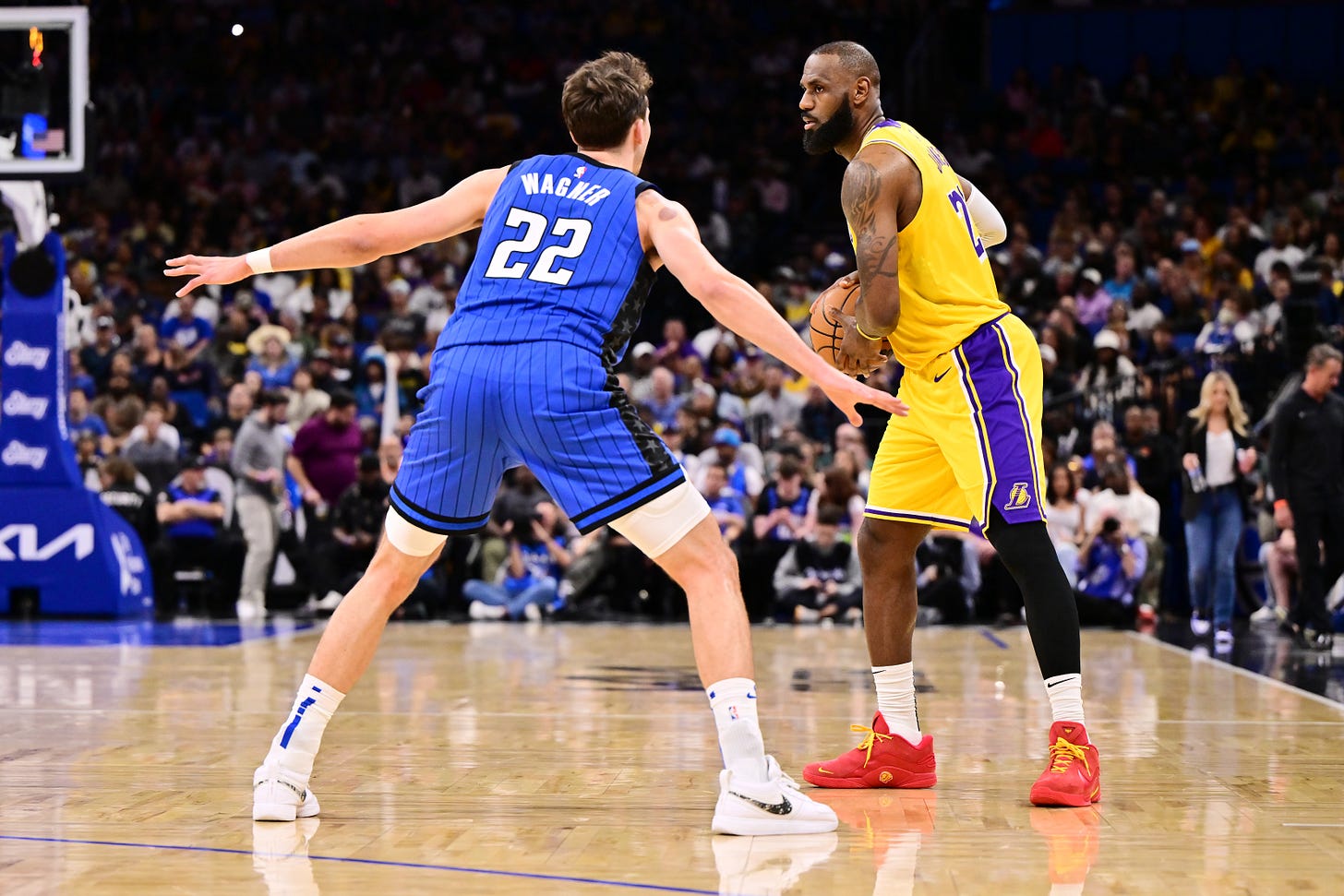NBA Size Games: Big, Small, and the Rise of Big-Smallball
Insights from Anthony Davis’ return, and the night the Lakers meet their oversized twin
The NBA season is a roller coaster. Just ask the Mavericks and the Lakers—two franchises linked forever by the stunning February trade.
For the Mavericks, Anthony Davis returned after missing 18 games with a left adductor strain he suffered in his Dallas debut, a much-needed relief after almost two months of blows. They beat the Brooklyn Nets for their second win in a row, keeping their play-in hopes alive.
The Lakers, on the other hand, are going through it. After hitting their high in early March, winning eight straight and looking like a contender, they can’t seem to find that groove and energy again. Even with injured players returning to the lineup, they’ve now lost three straight and seven of their last ten.
But last night, the Mavericks and Lakers games weren’t just about the usual ups and downs of a long NBA season—they also offered an intriguing display of how diverse the league really is when it comes to size and team-building strategy. Which is quite refreshing to see in a league that uneducated observers still love to describe as a copycat league where everyone’s playing the same.
Today’s highlights:
The NBA size landscape 📊
AD’s return to replicate Cleveland, Boston, and the 2020 Lakers blueprint 📊
The Lakers’ switch everything small-ball met its bigger match
1-The NBA size landscape 📊
I remember diving into the NBA size landscape a couple of seasons ago, right after the disappointing end to the Mavericks’ 2022–23 campaign. After trading for Kyrie Irving, the Mavs became one of the smallest teams in the league—and it showed. They couldn’t get stops, they couldn’t protect the rim, and they couldn’t make the playoffs. Since then, Nico Harrison has been on a mission to flip that identity completely. He drafted Dereck Lively II, then traded for Daniel Gafford and P.J. Washington. And judging by his boldest move—trading Luka Dončić for Anthony Davis—along with the reasons he gave for it and all the assets he’s spent on big men, that mission has turned into a full-on obsession with size.
Lively's injury, along with the injuries to Davis and Gafford that hit the Mavericks since the trade, has, in what some would describe as a karmic twist, transformed what was supposed to be the biggest back into the smallest team in the NBA. Before last night’s games, only Oklahoma City, with 74 percent of their playing time filled by players 6'6" or shorter, played more small players than Dallas did since the deadline. However, unlike the Mavericks, the Thunder were also near the top in playing time filled by players 6'11" or taller.
2-AD’s return to replicate Cleveland, Boston, and the 2020 Lakers blueprint 📊
What you can see from my team size breakdown chart is that there are many different team-building approaches across the league. Oklahoma City leans guard-heavy, pairing smaller lineups with their unique and aggressive, pressure-based defense. Teams like Atlanta, Portland, the Lakers, and Orlando favor long, wing-heavy rotations (more on that in the next section). Then there are teams like Milwaukee, Utah, Cleveland, and Boston that still give significant minutes to players taller than 6'11", sticking with more traditional size and often playing two-big lineups. Both Boston and OKC, with the addition of Isaiah Hartenstein, have the flexibility to morph between different models, which is what makes them so dangerous and two of the main favorites to win the title.
Nico Harrison and Jason Kidd have mentioned on several occasions that their goal is to replicate the model of that two-big group—specifically the Celtics, Cavaliers, and the 2020 championship Lakers, with Anthony Davis playing the power forward spot. I wrote about this new AD era—AD as in Anthony Davis, or After Dončić, however you want to look at it—right after the trade, outlining why the Mavericks’ decision-making brass is so drawn to it, as well as some of the concerns.
Last night, with Davis back on the floor for the first time since his emotionally charged debut, it was clear: the Mavericks are all-in on this vision.
Even without Lively and Gafford, Kidd played Davis almost exclusively at the four, alongside either Kai Jones or Dwight Powell, often with Washington as the small forward.
The effects were immediate and glaring, as the league’s worst interior defense suddenly looked like a menacing unit—one that made Nets attackers second-guess every drive to the rim and settle for countless tough, long-distance shots.
After allowing 128 points per game over the previous 11 games, the Mavericks held the Nets to just 17 points in the first quarter and 48 by halftime, even with Davis on a minutes restriction. Davis looked good in his first game back, making an impact on the defensive end as well by drawing double teams and making a couple of nice plays as a roll option in the pick and roll. Now, the lowly Nets aren’t exactly the best measuring stick to validate complex team-building questions. But this game served as a strong reminder of why I’ve argued the Mavericks should play Davis down the stretch this season—to get at least some sample of on-court minutes in this new setup. That way, they can head into the offseason with real data, not just hypotheticals. And Mavericks fans, still invested in the team, finally get to watch intriguing and competitive basketball.
3-The Lakers’ switch everything small-ball met its bigger match
Keep reading with a 7-day free trial
Subscribe to digginbasketball to keep reading this post and get 7 days of free access to the full post archives.








